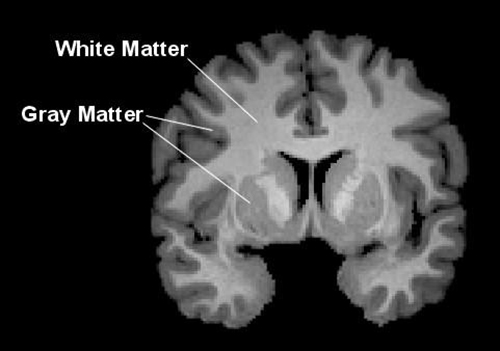![Gray matter is located on the surface of the cerebral cortex and also includes deep brain structures such as the thalamus and basal ganglia. White matter is located beneath the gray matter of the cerebral cortex and comprises long neural pathways that are responsible for transferring information between gray matter regions where the processing of information occurs. [Shawn Christ, Ph.D.]](https://genengnews.com/wp-content/uploads/2018/08/111684_web1642321564-1.jpg)
Gray matter is located on the surface of the cerebral cortex and also includes deep brain structures such as the thalamus and basal ganglia. White matter is located beneath the gray matter of the cerebral cortex and comprises long neural pathways that are responsible for transferring information between gray matter regions where the processing of information occurs. [Shawn Christ, Ph.D.]
At birth, children are screened for an array of genetic diseases that may quickly present symptoms and be potentially life threatening. One such rare disorder is phenylketonuria (PKU), a metabolic condition in which the body cannot convert the amino acid phenylalanine into tyrosine, a precursor of dopamine and other important neurotransmitters. PKU is hallmarked by the complete absence or underexpression of the phenylalanine hydroxylase enzyme. The disease is inherited by offspring through mutated genes from both parents and is rare, only affecting one in every 10,000 children in the U.S.—making it a seldom studied condition.
However now, researchers at the University of Missouri (MU) are using magnetic resonance imaging (MRI) to learn more about the effects of this disorder in the brain and to assist scientists in developing therapeutic drugs that help treat and control the disease.
Without treatment, phenylalanine accrues within the body and can cause severe health issues such muscular control problems, seizures, behavior problems, and intellectual disabilities. Once identified, patients with PKU are placed on a restricted diet that limits the amount of phenylalanine they consume, lessening the impact of the disorder—however, phenylalanine is found in many foods, especially those high in protein, such as eggs, milk, nuts, and meats, making dietary control difficult.
“A majority of the studies surrounding early-treated PKU examine the effects seen in the white matter of the brain” explained senior study author Shawn Christ, Ph.D., associate professor of psychological sciences, in the MU College of Arts and Science and director of the MU Brain Imaging Center. “Yet, only a handful of studies investigating the effects of PKU on gray matter have been conducted. We decided to add to the body of knowledge on this understudied aspect in those affected by PKU.”
The MU team decided to observe the effects of PKU on gray matter areas within the brain using advanced MRI techniques. Gray matter is located on the surface of the cerebral cortex and also includes deep brain structures such as the thalamus and basal ganglia. The investigators spent nearly 2 years mapping the gray matter of over 40 individuals with and without PKU and found evidence of gray matter abnormalities in individuals with early-treated PKU to be most severe in the posterior regions of the brain.
“We applied advanced morphometric methods to the analysis of high-resolution structural MRI images from a sample of 19 individuals with early-treated PKU and age- and gender-matched comparison group of 22 healthy individuals without PKU,” the authors wrote. “Data analysis revealed decreased gray matter (GM) volume in the parietal cortex for the PKU group compared with the non-PKU group. A similar trend was observed for occipital GM volume.”
The findings from this study were published recently in Molecular Genetics and Metabolism in an article entitled “Morphometric Analysis of Gray Matter Integrity in Individuals with Early-Treated Phenylketonuria.”
“Taken together with previous research on white matter and gray matter abnormalities in PKU, the present findings point to the posterior cortices as the primary site of neurostructural changes related to early-treated PKU,” the authors concluded.
“It is important for someone with PKU to maintain dietary treatment throughout their lifetime, but especially during early childhood to help prevent irreversible brain damage,” Dr. Christ added. “However, even if you keep phenylalanine low, these individuals are still at risk for difficulties due to the lower-than-normal levels of dopamine associated with the inability to produce tyrosine. We think that our research has the potential to contribute to better understanding the mechanisms underlying the abnormalities in brain and behavior associated with this disorder—thus, it may inform the development of new and exciting treatments for PKU.”
The researchers were encouraged by their findings and plan to join delegates from the National PKU Alliance to push for greater funding support for research on PKU and its impact on overall patient health.



